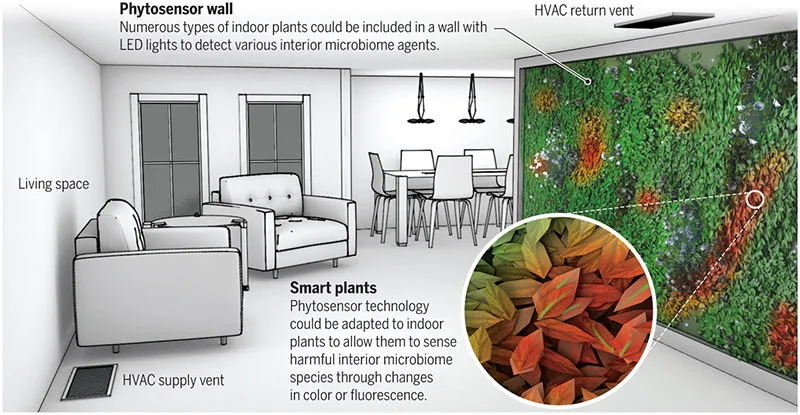Could Houseplants Keep Tabs on the Health of Your Home?
Researchers at the University of Tennessee look at the possibility of using plants as biosensors to detect dangers like mold or radon
/https://tf-cmsv2-smithsonianmag-media.s3.amazonaws.com/filer/dc/6a/dc6a86af-7158-4b6c-9571-aa2496f99ad0/spider_plant.jpg)
Your future home has all the modern amenities. Heliport for your flying car, robot chef, touch screen walls. And then there are the houseplants. They may look like ordinary spider plants and peace lilies. But one day, out of nowhere, the plants begin to glow an eerie purple.
Uh oh. You must have a mold problem. The plants, you see, are biosensors that monitor your home’s health: they can tell you when radon or carbon monoxide levels are too high, if there’s harmful mold lurking beneath the bathroom wallpaper, of whether someone in the house is exhaling flu virus particles, among other hazards.
As futuristic as it sounds, these houseplant biosensors may be a reality long before flying cars. A new article in Science from University of Tennessee researchers details the possibilities, in conceptual terms, of using genetically engineered plants to monitor our home environments.
“The idea is to engineer houseplants, your little green friends, to tell you about what’s going on in your house in a non-threatening way,” says Neal Stewart, a professor of plant sciences who led the research.
The article explores the feasibility of engineering different types of houseplants to give signals when they sense particular environmental contaminants. It also looks at how these plants could be best incorporated into home designs.
The best types of plants to use would be ones with large, variegated leaves and light-colored flowers, which would make color changes easier to detect, Stewart says. Plants could change color or fluoresce when exposed to hazards. Scientists have long known how to make plants fluoresce by inserting genes from fluorescent jellyfish into the plant's cells; the trick here would be making this fluorescence turn on only in the presence of certain stimuli like radon.
To get maximum visual information, you’d need more plants that just the occasional pot here and there. The researchers envisioned an entire “smart plant wall” that would be both visually appealing and give a high enough density of foliage to show off any color changes or fluorescence. The plants might be best positioned near the return vents of the home's heating, ventilation and air-conditioning system, as that's where gases like the volatile organic compounds (VOCs) emitted by molds would be most concentrated.

The idea of using plants as biosensors—AKA “phytosensors”—is not new. DARPA-funded research has shown that plants can be engineered to detect TNT, with some plant biologists hoping this could eventually lead to things like plant-based airport security systems, where passengers could wander through a garden whose plants would alert authorities to the presence of drugs or explosives. Other research, including Stewart’s own, has demonstrated that plants can be engineered to detect their own diseases, letting farmers know if there’s a threat in the greenhouse.
“Just as we can imagine a series of field-deployed pathogen phytosensors giving an early warning of plant disease, we can imagine home sentinel phytosensors visibly warning of mold or other hazards before they can affect our health,” reads the paper in Science.
K. Peter Pauls, a professor at plant agriculture at the University of Guelph in Ontario, says a houseplant biosensor wall is “not out of the realm of possibility.” To get there, the researchers would need to set up a cascade of events within the plant so that it’s sensitive to whatever they want it to detect (radon, mold, etc.) and tie that to a visual reporter system like color-changing or fluorescing.
“I don’t imagine it would be too much of a stretch to couple that responder [the color-changing or fluorescence] to a sensing system of some kind,” Pauls says.
For Stewart and his team, the next step will be to engineer some plants to respond to specific stimuli and begin to conduct experiments. They don’t envision phytosensor walls coming to a home near you anytime soon, but see the project as a long-term process, perhaps involving citizen scientists helping with the research by doing at-home experiments with engineered plants.
The work was a collaboration between Stewart and his wife, Susan Stewart, and UT interior design professor Rana Abudayyeh. Susan Stewart is studying interior design at the university.
“She was telling me about her classes, and they were doing these neat conceptual projects dealing with plants and bioluminescence,” Neal Stewart says. “I was thinking that’s pretty far out—we should work together.”
/https://tf-cmsv2-smithsonianmag-media.s3.amazonaws.com/accounts/headshot/matchar.png)
/https://tf-cmsv2-smithsonianmag-media.s3.amazonaws.com/accounts/headshot/matchar.png)